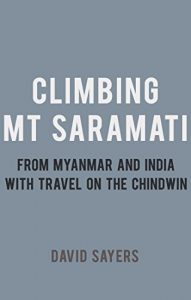Unknown Mt Saramati is the dominant peak along the mountain border between India and Burma. Long guarded by Spirits, even today few tribal hunters venture upon its forested upper slopes, and early last-century naturalist explorers, realising its scientific significance, could only dream of studying it.
Today, its once fierce headhunting colourful Naga tribespeople are welcoming, and for anyone seeking travel in remote areas it would be hard to beat this border country since its rugged terrain and hill top villages still see few outsiders. For the naturalist, there is everything waiting to be discovered as it has been little studied. Birding, botany, anthroplogy and trekking are the main attractions, and simply being right away from mainstream civilisation.
Naga tribes live on both sides of the Indian/Burma (Myanmar) border, and the Burmese side has had much less contact with the outside world. Now there is growing awareness among more intrepid travellers of the attractions of this Saramati region and already local agencies can provide support and obtain the necessary permits.
For the more adventurous, Mt Saramati (3826 m) itself can be climbed, from either the Nagaland or Burmese side, and this book describes both routes. India offers the easier option, still a challenge; from Burma it has been climbed only three times.
Drawing on personal diaries and a published account in Burmese of the first ascent from Burma in 1959 by two IUCN naturalists and Burmese Forestry Officers, the trek to the mountain with its problems with porters and guardian spirits and the ultimate successful ascent is retold. A lengthy description of their experiences of travel on the Chindwin river over 50 years ago provides a marvellous read for anyone planning the journey today, either independently or on a luxury cruise.
The approach and ascent from the Nagaland (Indian) side describes a botanical tour led by the author in 2004, and includes Mt Japhu (3043 m) and the Dzukou valley.
Today, its once fierce headhunting colourful Naga tribespeople are welcoming, and for anyone seeking travel in remote areas it would be hard to beat this border country since its rugged terrain and hill top villages still see few outsiders. For the naturalist, there is everything waiting to be discovered as it has been little studied. Birding, botany, anthroplogy and trekking are the main attractions, and simply being right away from mainstream civilisation.
Naga tribes live on both sides of the Indian/Burma (Myanmar) border, and the Burmese side has had much less contact with the outside world. Now there is growing awareness among more intrepid travellers of the attractions of this Saramati region and already local agencies can provide support and obtain the necessary permits.
For the more adventurous, Mt Saramati (3826 m) itself can be climbed, from either the Nagaland or Burmese side, and this book describes both routes. India offers the easier option, still a challenge; from Burma it has been climbed only three times.
Drawing on personal diaries and a published account in Burmese of the first ascent from Burma in 1959 by two IUCN naturalists and Burmese Forestry Officers, the trek to the mountain with its problems with porters and guardian spirits and the ultimate successful ascent is retold. A lengthy description of their experiences of travel on the Chindwin river over 50 years ago provides a marvellous read for anyone planning the journey today, either independently or on a luxury cruise.
The approach and ascent from the Nagaland (Indian) side describes a botanical tour led by the author in 2004, and includes Mt Japhu (3043 m) and the Dzukou valley.












